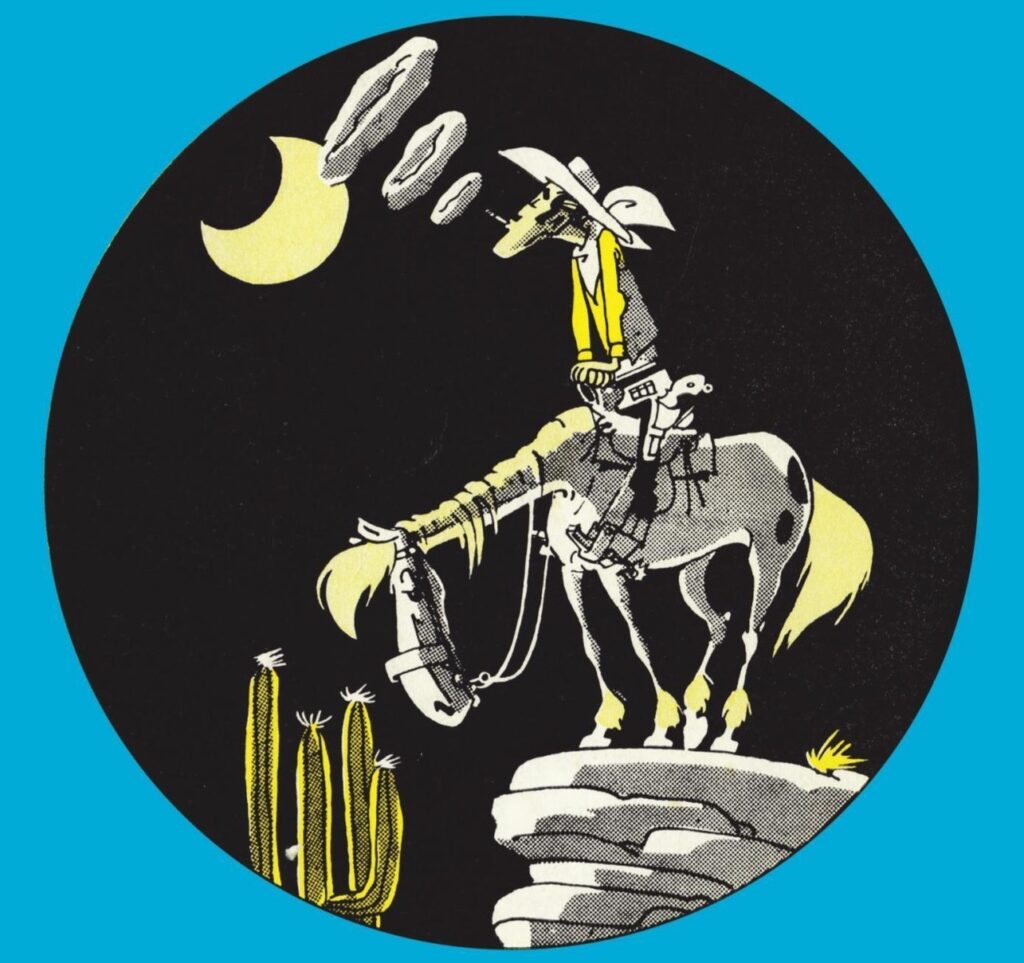
Last year, when I did a couple of posts about The Adventures of Tintin, I naively mentioned I wanted to write more, throughout 2022, about the Belgian bandes dessinées I read growing up. My work schedule didn’t allow me to fulfill this plan and I doubt 2023 will be much different… Still, I’ll try to make it at least a yearly thing, not so much out of nostalgia, but because I find it interesting to look back on these books now and to place them in a historical context that was far from my mind when I first encountered them as a kid.
This time around, I want to focus on the early years of the popular western comic Lucky Luke, originally written and drawn by Morris.
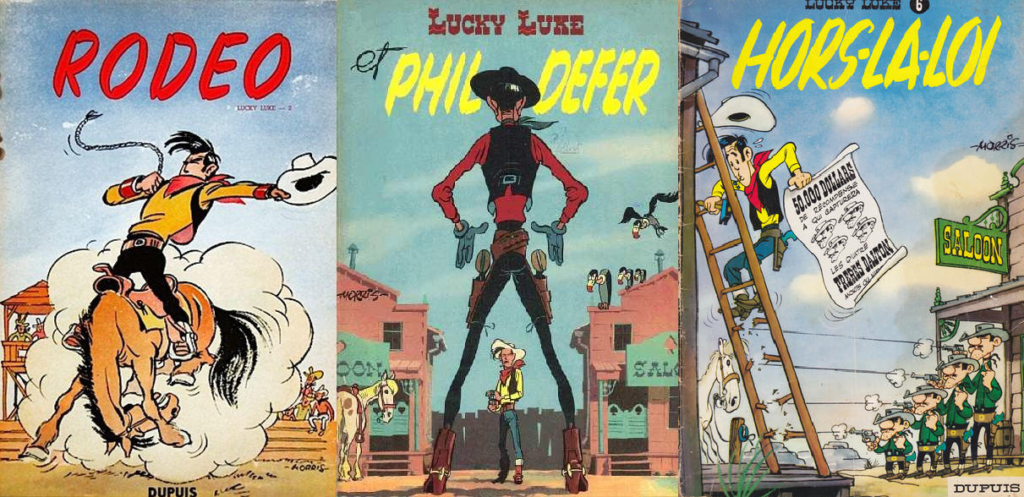
Now that I think about it, the dozens and dozens of books (or ‘albums,’ as BD books are usually called) about the quick-draw drifter Lucky Luke – and his faithful white horse, Jolly Jumper – must’ve been where my whole passion for westerns started. This is where I first came across many of the genre’s tropes – and while I could spot the silliness in the series’ exaggerated depiction of the so-called Wild West, I also approached the stories as rip-roaring adventure yarns involving exciting gunfights in a violent, quasi-lawless world.
For all its caustic comedy, Lucky Luke didn’t immediately strike me as a spoof of something that took itself seriously – in fact, when I later found John Ford’s and Howard Hawk’s movies, in my teens, I think I fell in love because they looked like a more serious version of something that I used to consume as a child, almost as if those were the revisionist texts rather than the other way around (that said, those films contain plenty of humor themselves…).
I’m sure it helped that, when I first met him, Lucky Luke was a damn cool dude:
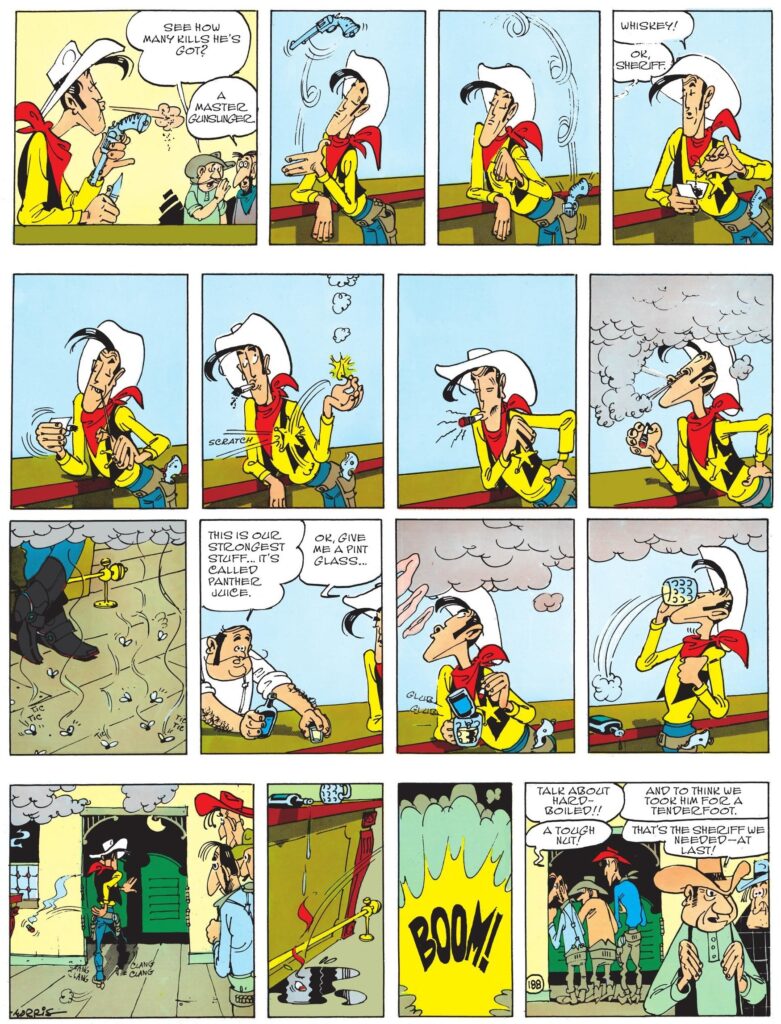
Clean-up in Red City
The page above is from one of the first albums I read, Lucky Luke versus Pat Poker, which also happened to be the oldest one I owned (it was originally published in 1953). There are a few older albums, however, which I only checked out recently and which would’ve probably made a somewhat different impression…
As many a fan knows, a series’ first installments aren’t always the best place to start, as some concepts take a while to find their feet. For instance, you shouldn’t try to get into Terry Pratchett’s Discworld through The Colour of Magic (I personally recommend the fourth book, Mort) or into Judge Dredd through The Complete Case Files 01 (you’ll be better served with the volume 02, which collects the classic arcs ‘The Cursed Earth’ and ‘The Day the Law Died!’). Likewise, those initial Lucky Luke comics are still extremely crude compared to what was to come.
By the time Morris created and developed Lucky Luke, on the pages of the Belgian BD magazine Le Journal de Spirou in the mid-to-late 1940s, there was already quite a tradition of western comedies drawing humor from the genre’s conventions, including classic films featuring Buster Keaton, Laurel & Hardy, Bob Hope, and the Marx Brothers. However, having now tracked down the strip’s very first stories, I can’t help noticing a much more specific influence: the very basic plots (which are little more than loose springboards for Morris to draw the hell out of dynamic fights and chases), the rounder designs, and the cartoony slapstick owe a crystal-clear debt to American animated shorts, most notably the ones about Popeye the Sailor Man.
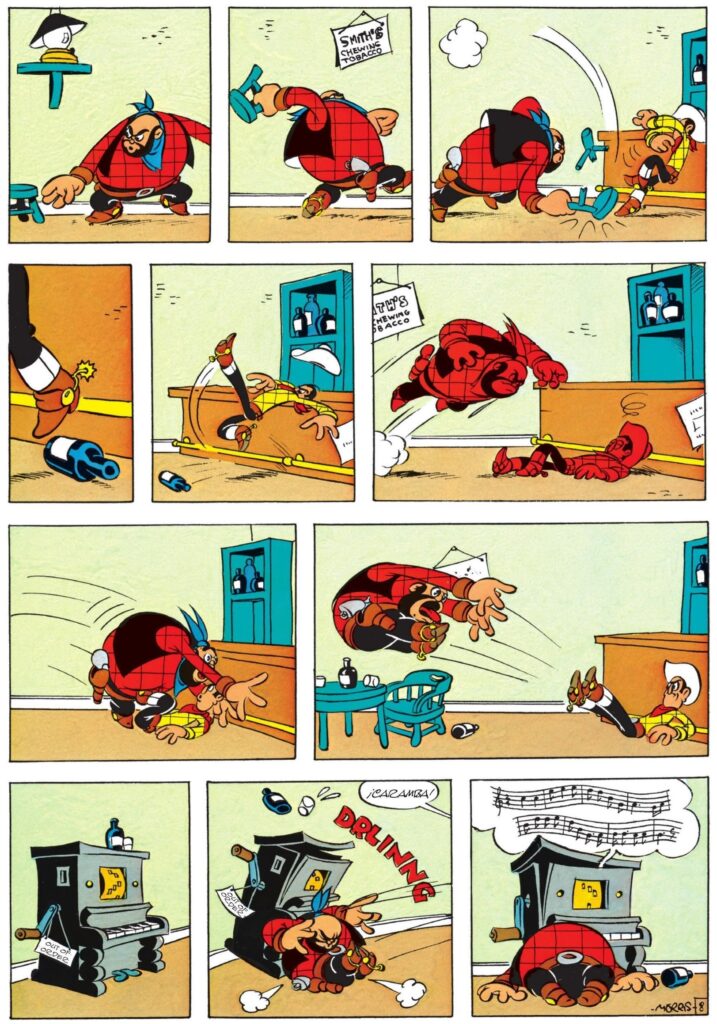
Arizona
More than a pastiche of horse operas, then, Lucky Luke started out as a comic-book version of the kind of stuff Max Fleischer, Tex Avery, and Chuck Jones were doing on the screen. Seriously, I keep expecting Droopy Dog to pop up in ‘Lucky Luke Versus Cigarette Caesar,’ where an escaped convict tries to flee from Luke but constantly runs into him no matter where he goes (the latter even hides inside a cactus and at the bottom of a well), almost as if our lonesome cowboy has suddenly gained supernatural powers. The whole thing is unabashedly goofy, rejecting any sense of realism for the sake of nonsense gags (one of which anticipates Leone’s A Fistful of Dollars). And so, along with the clichés of the western genre, we get the clichés of that era of comedy!
A Belgian creator in the postwar years doing stories about the mythology of the United States, inspired by Hollywood movies and cartoons, may seem like a straightforward case of cultural imperialism, with a triumphant USA flooding a devasted Europe with its values and imagery in the aftermath of WWII. Indeed, Morris was an Americanophile, but he didn’t just access the US from the outside: he traveled throughout the country – and through Mexico – in search of landscapes and inspiration before moving to Brooklyn in 1948, where he lived for a few years, absorbing American culture from within while watching westerns on television and doing research at the New York Public Library.
According to the introduction in the second volume of Cinebook’s Lucky Luke: The Complete Collection, it was during this research that Morris came to know more about the Dalton gang, whom he used as characters in the story ‘Outlaws’ (and whose fictitious cousins later became Lucky Luke’s most recognizable recurring villains). Morris made up the Daltons’ comical appearance, but he allegedly based their demeanor on his impression of reality: ‘accounts followed where the Daltons were often referred to as “eternal runners-up” of crime, and it’s easy to see why. The reality was that they envied their cousins, the James brothers, who were truly dangerous bandits, and they wanted to match their exploits. Unfortunately, they had neither the intelligence nor the skill. Actually, I’m convinced they were complete idiots. All of their attacks on banks and stagecoaches were poorly prepared, turned into terrible bloodbaths, and only yielded measly loot – peanuts, really.’
On top of depicting the Dalton brothers as incredibly stupid and nasty, Morris originally tried to get some dark laughs out of their pathetic deaths through a gory drawing of the leader of the gang, Bob Dalton, getting shot in the head by Lucky Luke. However, publisher Charles Dupuis ordered the image modified out of fear that the story would get banned in France by the Committee in Charge of Surveillance and Control over Publications Aimed at Children and Adolescents (whose censorship had a protectionist agenda and was usually stricter with Belgian imports), which would’ve deprived them of the coveted French market.
Yes, I mentioned that Lucky Luke was meant to shoot Bob Dalton. In fact, in the earlier comics it was not unheard of for the series’ protagonist to kill his opponents – something that changed precisely in response to France’s censorious law of 1949, turning Lucky Luke into a more virtuous hero.
As with Batman, though, this refusal to kill didn’t make Luke any less of a badass. Hell, it made him even more impressive and the resolutions to his conflicts necessarily more imaginative:
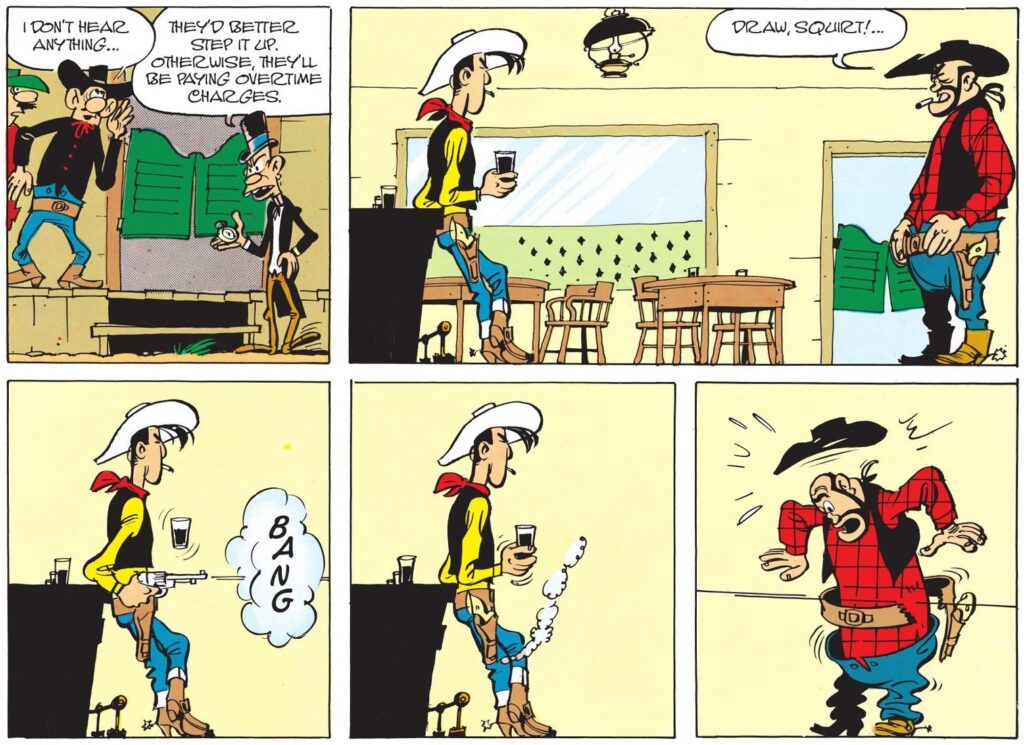
Rails on the Prairie
That said, for a bit in the early 1950s the tendency was actually for Lucky Luke to turn, if not exactly grittier, at least less cartoonish. You can see this in the two tales collected in Lucky Luke versus Pat Poker, ‘Clean-up in Red City’ and ‘Rough and Tumble in Tumbleweed.’ The first one is a variation of the film Destry Rides Again: assigned to clean up a town where sheriffs have a limited lifespan, Lucky Luke is initially underestimated by the town’s folks, who patronize him as a harmless tenderfoot, but he soon turns things around, using his wits as well as his guns and fists.
The memorable main villain here is the card shark Pat Poker, who is such a scoundrel he even cheats when playing alone:

Clean-up in Red City
As you can see from this example, there is still humor to the proceedings, although it’s not the central focus anymore, just something that makes the action more colorful. Even when the gags are slightly surreal, the whole thing generally feels more like a comedic western than like a western comedy.
I can’t tell you how many times I’ve read Lucky Luke versus Pat Poker as a kid, but I’m guessing the number would be in the dozens, as I still recall almost every scene by heart. It was never my favorite Lucky Luke comic, but it left a mark – no matter how much of a goody goody two shoes he became in later albums, for me Lucky Luke was always cool because I had seen how much butt he could kick when push came to shove.
For instance, check out this thriller-worthy, Hitchcockian sequence in which Pat Poker tries to have our hero shot from across the street but Lucky Luke turns the tables on him while acting in complete control of the situation:
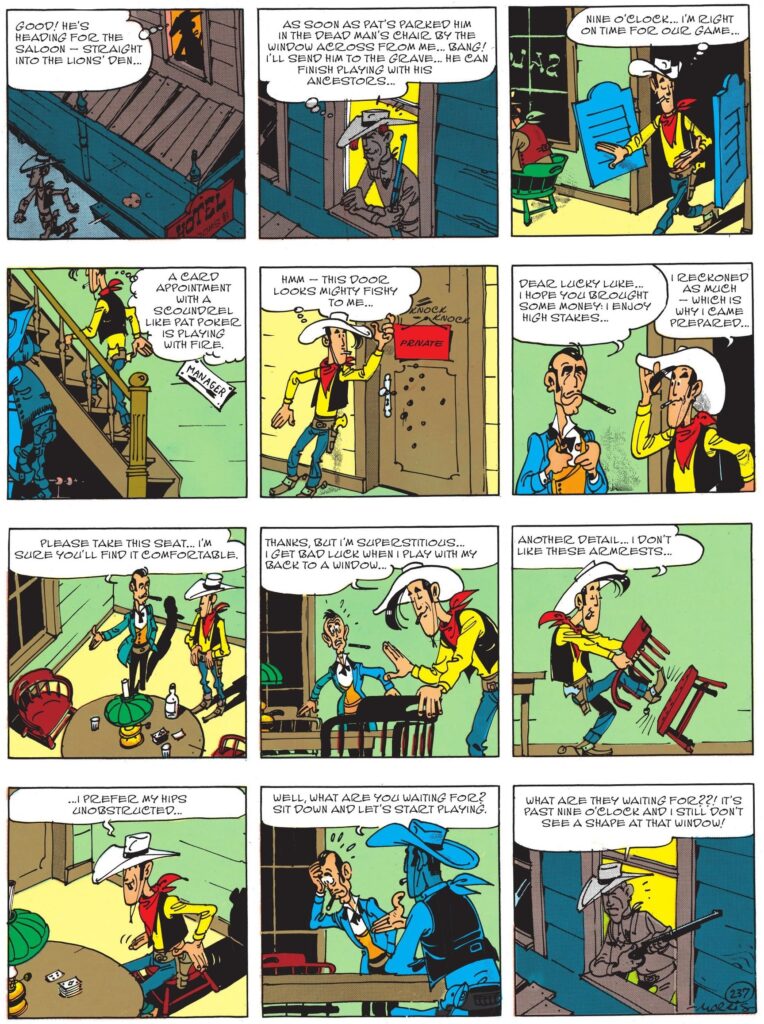
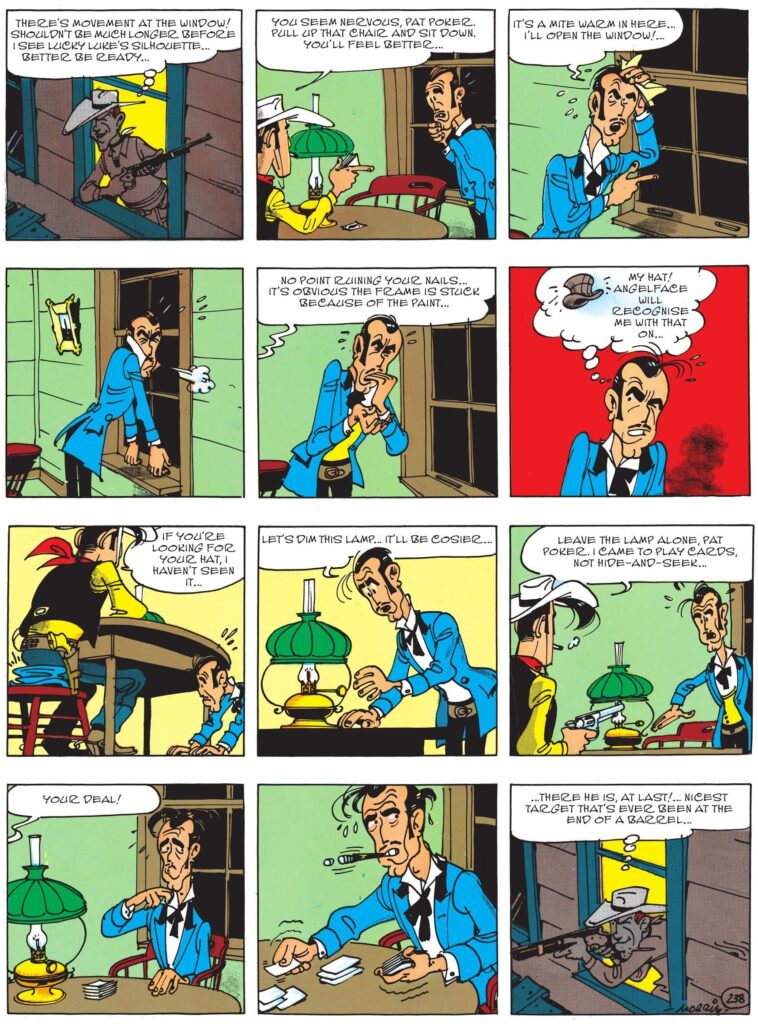
Rough and Tumble in Tumbleweed
Since this was the oldest album I owned, I always assumed Lucky Luke had begun as a (togue-in-cheek) western and gradually moved toward outright parody. As it turns out, zany humor was at the core of the series from the start and there was only a brief intermediary period where things seemed to be going in a different direction.
The return to full-blown comedy in the mid-1950s can be explained through two main factors, as outlined by Christelle and Bertrand Pissavy-Yvernault’s informative introductions to the first volumes of Lucky Luke: The Complete Collection. In New York City, Morris used to hang out with comic-book creators John Severin, Jack Davis, Will Elder, and Harvey Kurtzman (whose first names, Pissavy-Yvernault speculate, inspired the names of the Daltons’ cousins), having followed up close the conception of EC’s MAD Magazine, whose parodic style proved to be an important influence. Also in New York, Morris met René Goscinny, who eventually became Lucky Luke’s prolific scriptwriter for the following decades and whose sense of humor ended up shaping the series’ identity.
Indeed, Goscinny’s intial album, Rails on the Prairie, is already packed with the same relentless mix of anachronisms, puns, and social satire – plus an ironic narration – that you can also find in his scripts for Asterix and Iznogoud:
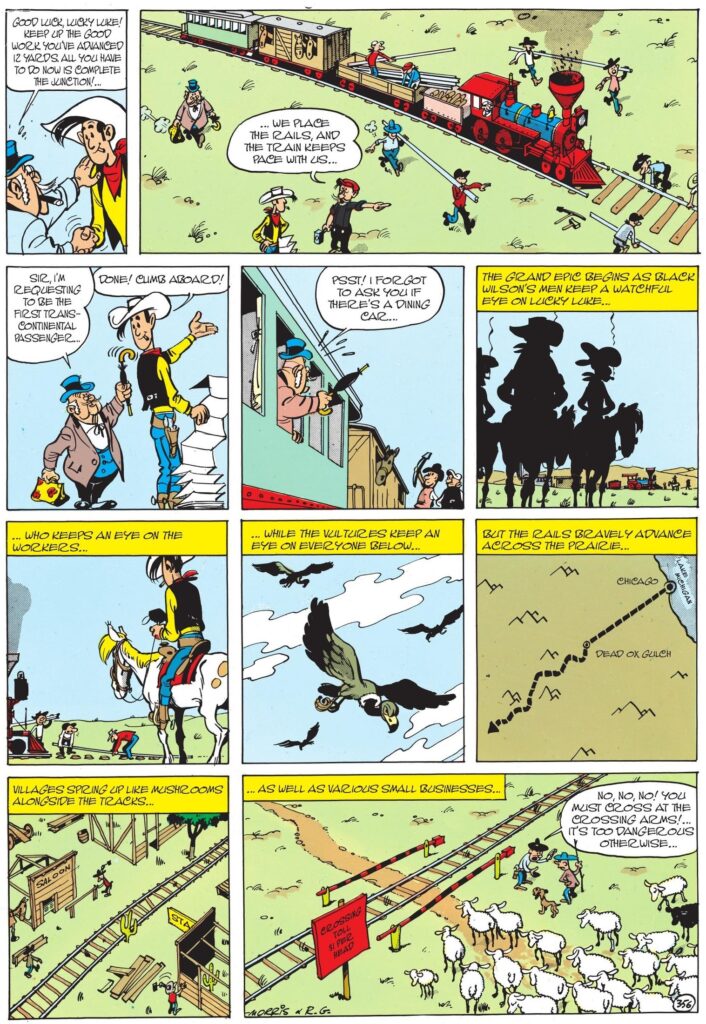
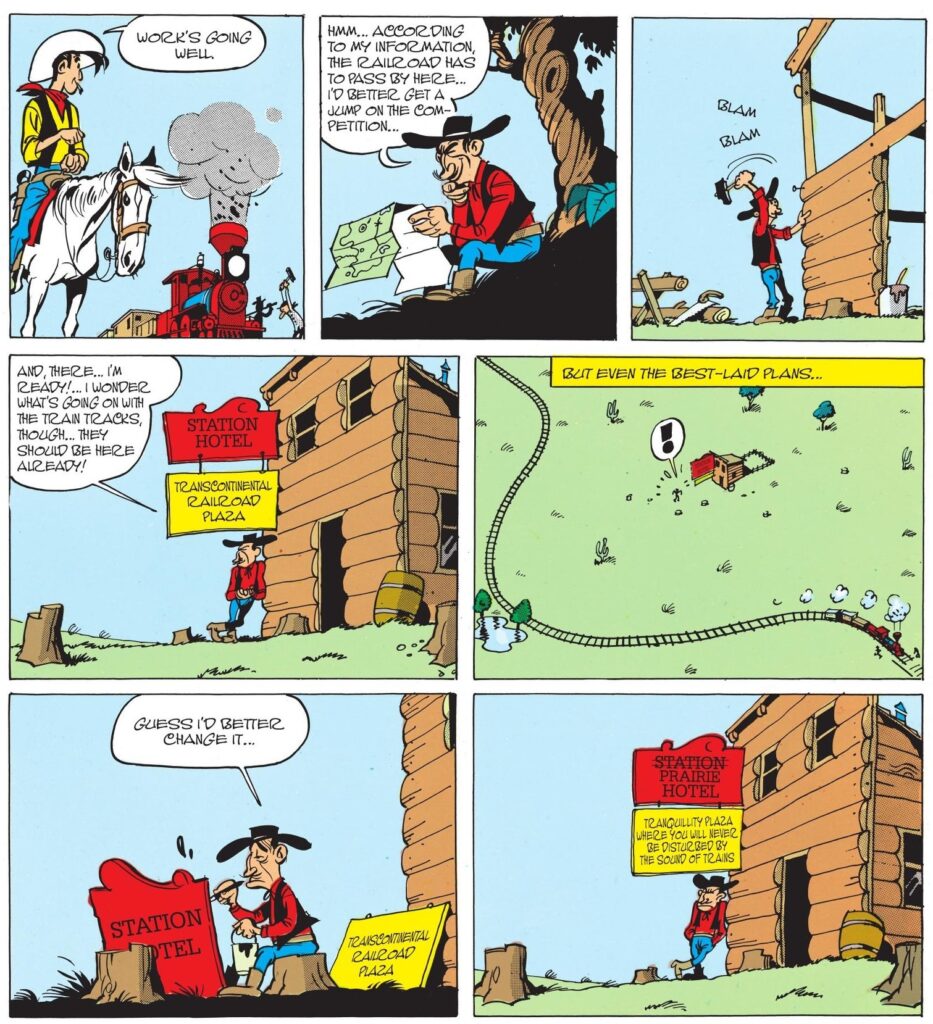
Rails on the Prairie
Next week, we’ll look closer at Lucky Luke’s approach to humor.

Lucky Luke was and still is my favourite comic book. Thanks for sharing.